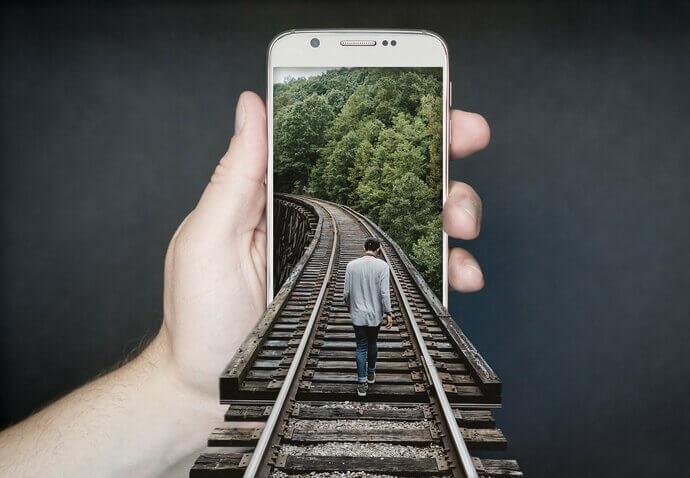You probably own or work at railway services. It could be metro or passenger trains. And you want to make it easier for the passengers to travel.
You are now thinking of making your services and operations better. And you’ve seen many industries using QR Codes to do the same.
So you want to explore the utility of QR Code technology for your business. Let us tell you that you’re actually right.
QR Codes are used to store information. And unlike traditional barcodes, they can store a lot more information. Hence, they’re used for a wide variety of use cases. From payments to marketing, QR Codes are being used in all.
But that’s not where it ends. QR Codes can help you a lot more than this. It could be making the ticketing process better, tracking shipments, and helping the customer make payments easier.
Wondering how? Keep reading to know.
A. How QR Codes are useful in railway
1. Ticketing
Thousands of passengers travel by public train on daily basis. And you know it is common for them to face issues such as missing the train or misinformation about arrival time from the internet.
But QR Code technology can help you take care of these issues effectively. Here’s how:
a. Make boarding and payments faster
QR Codes can help passengers buy metro as well as railway tickets quickly. How? By simplifying the process via an automated evening machine or online portal.
Why the online portal? Well, that’s because many times, people have to book the tickets in advance to get reservations. This means they won’t straight go to the vending machine and get a ticket (unlike the metros).
And in both scenarios, QR Codes can help them out. Here’s how:
1. Passengers visit the online portal or automated ticketing machine available at the station
2. Here, they need to enter details such as departure, date and time of boarding, and destination
3. Once done, they see a variety of train options to choose from
4. Here, they can select any one of them and proceed to enter their contact details such as name, age, gender, and seat preference
5. After submitting these details, they need to pay for the ticket
6. Here, they see QR Code-based payment option amongst other payment options such as cash or card
7. If they select the QR Code payment option, it generates a QR Code
8. Then, they just need to scan this QR Code and proceed to enter the pin
9. Once done, the fare will be deducted and the ticket gets printed
This way, boarding the train becomes a faster process and passengers get convenient options to make payments.
Generate a QR Code For Your Unique Case
START TODAY!
b. To keep a track of transportation schedules
It is quite common to miss a train due to wrong information about its timing. But not anymore.
QR Codes are here to solve this problem. They help passengers keep an eye on the schedule of their train.
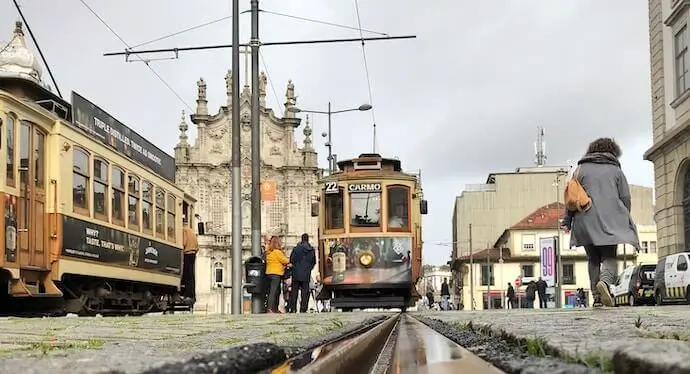
To do it, you just need to offer QR Codes on printed tickets. Travelers can scan them to go to your railways portal and keep an eye on the transportation schedule.
In fact, train authorities also place QR Codes having all the details about departing trains at the railway premises. This way, anyone can scan them to view all the information instantly. This would minimize the chances of passengers missing their trains due to misinformation.
2. Passenger verification during transportation
You would have seen QR Codes to make payments at bill desks. But that’s not their only use case here. How?
Railways board thousands of people on each train. And it is the responsibility of the ticket checker to authenticate the travelers’ identity. They do it by manually verifying the travelers’ details with their travel charts.
But here’s the problem—this is a tedious and long process. While it keeps the passengers waiting, it’s also prone to human error.
Moreover, these tickets don’t guarantee against forgery and trespassing. But don’t worry.
A QR Code can make transportation safer in such situations. Just create a QR Code with the traveler’s details in it.
Once done, place it on railway tickets. Ticket checkers simply have to scan the QR Code on each ticket to verify their details and authenticate their travel. That’s it. That’s how simple and easy it is.
To help you understand it better, here’s an example. India railway adds QR Codes to its printable e-tickets. When scanned, they show complete ticket details such as:
- PNR
- Train number
- Scheduled departure
- Scheduled arrival
- Train name
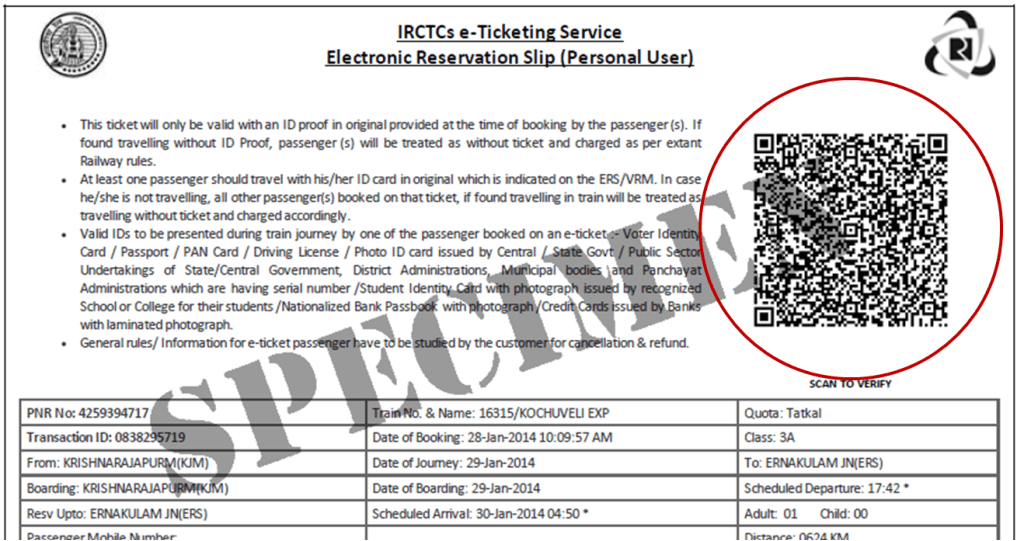
3. Shipping and inventory tracking purposes
In addition to traveling, QR Codes are also useful in shipping and inventory management. Here’s how:
a. Shipping of goods
While the transportation and shipment, damage or loss of goods is a pretty common issue. Earlier, operational managers had to appoint staff on the payroll just to make sure the safe dispatch and delivery of products.
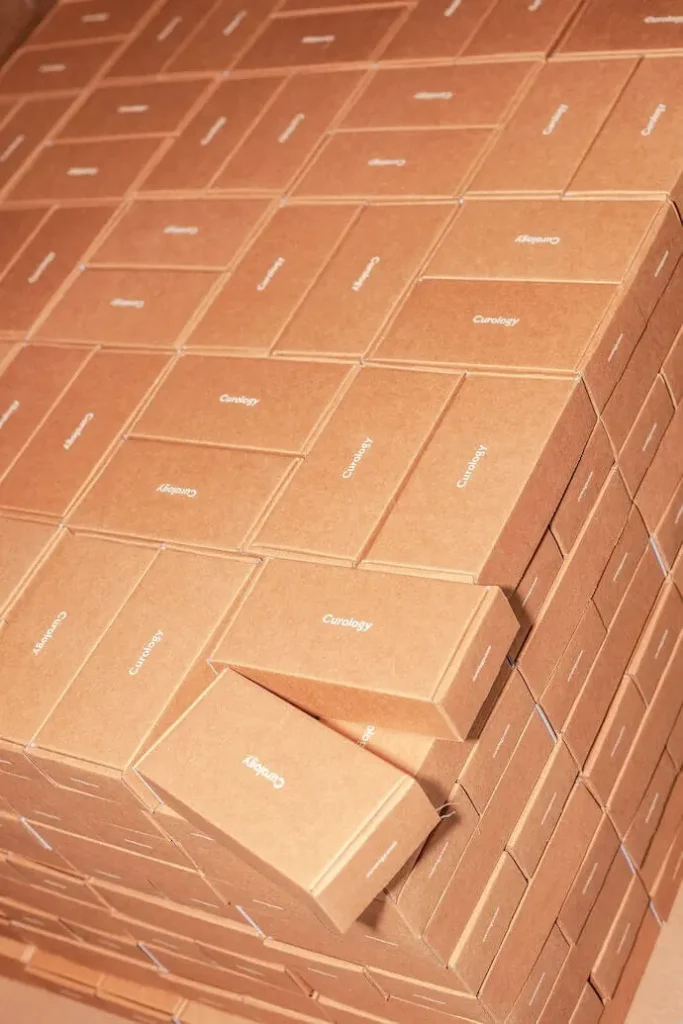
But that’s not necessary anymore. QR Codes can actually help automate this process.
Here, you just need to add QR Codes to the packaging of your shipments. And you can scan these QR Codes at each step for goods in transit. From goods leaving the inventory to finally getting delivered, they can help you track it all.
To get even better accuracy, you can even make use of QR Codes’ GPS tracking feature. It allows you to easily track the whereabouts of the goods.
b. Inventory tracking
QR Codes were originally developed for the sole purpose of inventory management in 1994. And it still continues to be one of their major use cases till today. How?
Earlier, people used to hire a person to keep inventory in check. And this person had to be physically present at all times during inventory check-in or check-out.
Now, this process has become much simpler. Just put a QR Code on each item. And the responsible personnel would scan it to maintain a log of the shipment details. This way, you can efficiently monitor details such as the location of goods, inventory status, and their log information.
C. How to create a QR Code for railways
Now you know how QR Codes in railways are useful. The next question—how to create them?
Depending on what you want your end-users to see, you’d need to select the right QR Code category. For example, if you want to share passenger details, you’d need a Text QR Code. Similarly, if you want to use them for inventory purposes, you’d need Serial Code QR Codes.
Once decided on the QR Code category, you can head on to your chosen QR Code generator.
Generate a QR Code For Your Unique Case
START TODAY!
Here, you need to decide whether you want QR Codes in bulk or not. That’s because some use cases require them in bulk such as inventory management. And in that case, you need a bulk QR Code generator.
In case you don’t need them in bulk, you can go for any QR Code generator. And to find it, you need to go to Google and type the query.
This will give you many results to choose from. For your convenience, here is a detailed comparison chart on the best QR Code generators available online. You can go through it to make a sound decision.
1. Create a QR Code one by one
Using the Scanova QR Code generator for a demo, here is how you can create a QR Code:
a. Go to Scanova
b. Select the most relevant QR Code category
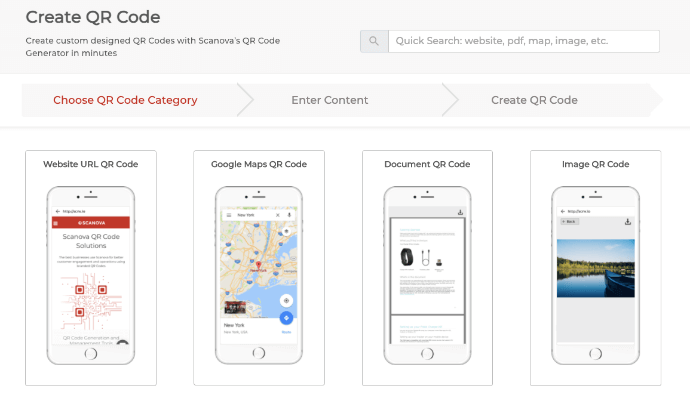
c. On the page that loads, add the content you want to encode in the QR Code and click Continue
d. Name the QR Code and click Create QR Code
e. Now, you’ll see the preview of the QR Code on the right. Under it, you’ll see the Edit Design button. If you click on it, you’ll see two design options—Custom Logo Design and Custom Background Design
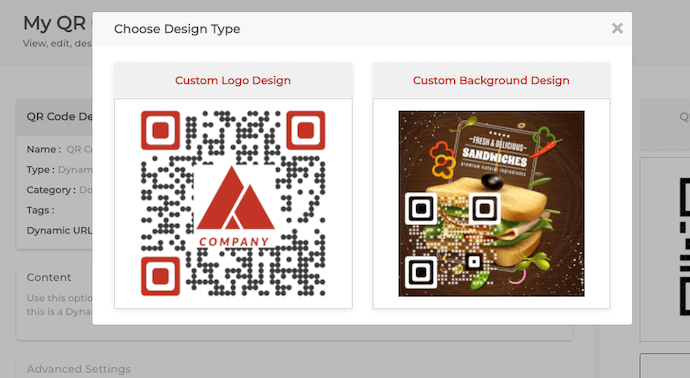
Custom logo design allows you to add your business’s logo and colors to the QR Code. On the other hand, custom background design helps you place your QR Code on any image
f. Once you’ve decided on design or no design, click Download. A window will open, prompting you to sign-up for a 14-day free trial. Once you’ve signed up, proceed to download the QR Code
g. Now, you’ll be asked to specify the QR Code image’s format and size
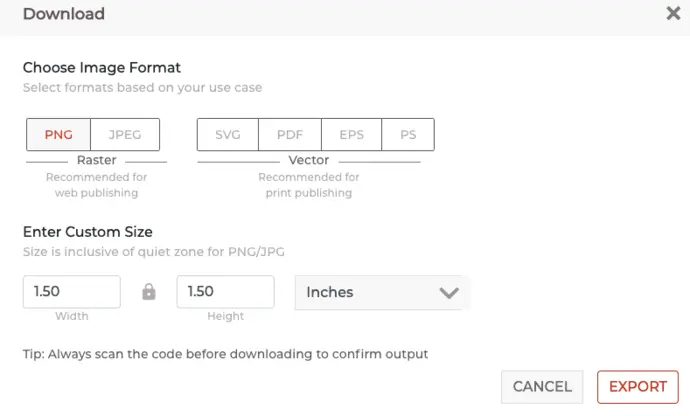
h. Specify these details and click on Export
That’s it. Your QR Code will be downloaded. It is always advisable to test scan the QR Code before putting it out for the target audience.
2. Create QR Codes in bulk
In case, you want to create QR Codes in bulk, then you can go ahead with this option.
To do it, you’d need a bulk QR Code generation service. It allows you to create up to 100,000 QR Codes in one go. Thus, it eliminates the need to generate QR Codes one by one.
Bulk QR Code generation service offers a variety of choices. For example, Website URL QR Codes, Simple Text QR Codes, Serial Code QR Codes, and VCard QR Codes.
To make use of it, you simply need to upload a data file in XLS, CSV, or XLSX formats. And this file needs to have all the data to be encoded in the QR codes. Once done, you just have to wait for the QR Codes to be generated and download them in a zip folder.
For more information, here is a detailed guide on how to generate QR Codes in bulk.
That is all you need to know about how QR Codes can be used for the railway. You can now get started on delivering passenger delight using QR Codes for your business operations.
Do you know you can also integrate QR Code generation into your railway information system via QR Code API? Here’s a quick guide to learn more about it.
Generate a QR Code For Your Unique Case
START TODAY!
